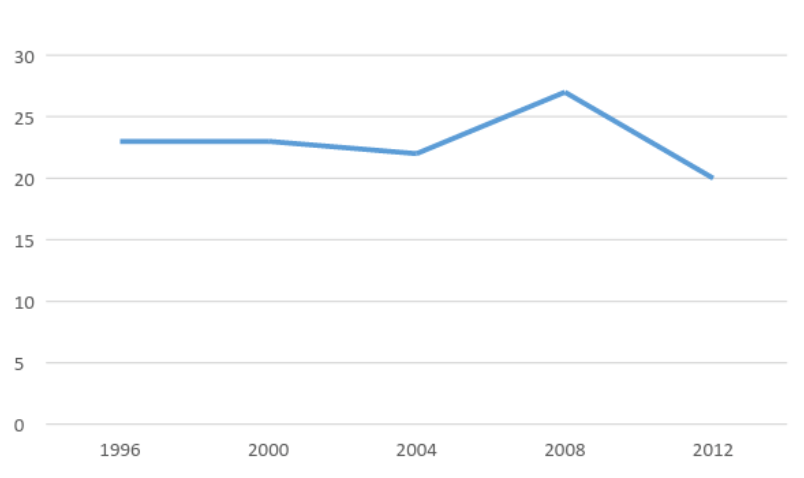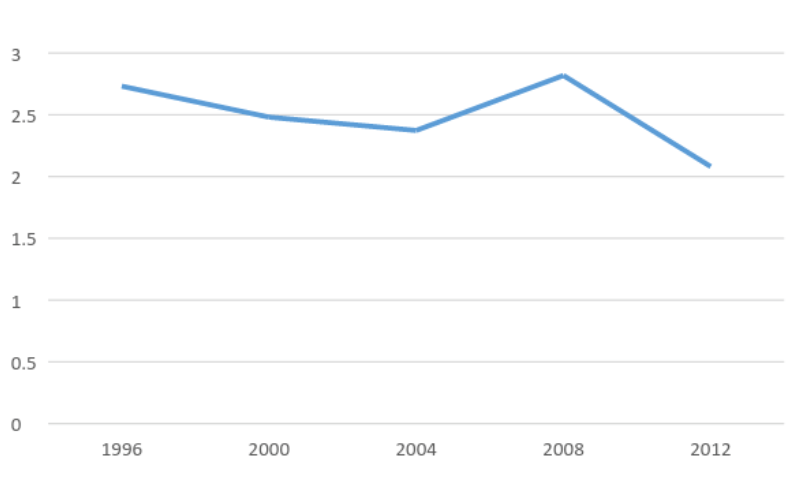Strategy 2020 includes a lot of ambitious goals. Among them winning 35 medals at the 2020 Summer Olympic Games in Japan. Increases like Ukraine hopes to achieve are unlikely but not impossible. Home advantage, investments and even size of GDP increase the medal count.
At the beginning of 2015, the Ukrainian president approved the Strategy 2020 program, a strategy which includes 25 key performance indicators (KPI) which can be used to assess Ukraine’s progress in implementing the strategy program. In a series of upcoming posts we will evaluate how likely it is that Ukraine will reach some of these KPIs by 2020 [1]. The first KPI we will evaluate is ‘winning 35 medals at the 2020 Summer Olympic Games in Japan’.
Ambitious plans
Looking at Ukraine’s performance in the Summer Olympics so far, one can observe that Ukraine’s medal count varies around 24 medals, with a high of 27 medals in 2008 and a low of 20 medals in 2012.
Fig. 1. Ukraine’s medal count over the years

Similarly, the share of Ukraine in the total medal counts varies around 2.5%.
Fig. 2. Ukraine’s medal share over the years (in percentages)

The goal of Ukraine to reach 35 medals in 2020 thus means Ukraine wants to increase its medal count by 15 medals and its medal share by 1.5 percentage points as compared to the most recent Olympics, the 2012 Olympic Games in the UK.
Progress so far
The next Olympic Games are only in 2016 so it is hard to measure progress so far. Still, the forecast for the 2016 Olympic Games by Infostrada Sports shows again 20 medals for Ukraine. The same number is predicted by Luciano Barro, former sports managing director of the Italian National Olympic Committee. Finally, Noland and Stahler (2015) predict Ukraine will drop from place 11 (2012) to place 14 in the 2016 medal count. These forecasts, most likely, have been made before the announcement of the Ukraine’s goal to reach 35 medals, however.
Is it likely that Ukraine will reach this goal?
There are several ways to evaluate how likely it is Ukraine will reach this goal. First, we can do an evaluation based on Ukraine’s historical performance. From the graph above, one can see that in the past Ukraine increased at most 7 medals over a period of 8 years (from 20 in 2000 to 27 in 2008). Hence, based on its own past performance, an increase by 15 medals seems, to put it mildly, rather ambitious.
Second, we can do an evaluation based on a comparison with other countries. If one looks at 8 year periods since 1996 [2] (i.e. 2004 versus 1996, 2008 versus 2000 and 2012 versus 2004), one can see that out of the about 200 countries participating, only 4 countries increased their tally by at least 15 medals, the UK (organizers in 2012), China (organizer in 2008), Russia and Japan. 4 out of 201 makes 2%, a low likelihood indeed. If one looks at 4 year periods, also Australia (organizer in 2000) succeeded in such increase. Looking over 12 year periods, however, only China, the UK and Russia succeeded in such increase suggesting that a 15 medal increase is not only exceptional, but also hard to sustain.
Of course, one could argue one should compare Ukraine to its peer group rather than to all participating countries. This peer group could consist of similar countries in terms of wealth, population size or even goals set. To do this, one can use regression analysis. Regression analysis allows to compute a country’s potential, where potential is defined as the number of medals a country can expect given certain parameters like its population, wealth, and other variables that potentially can influence a country’s medal count. The papers mentioned above use regression analysis and do not predict a huge increase for Ukraine [3].
Moreover, from looking at past statistical predictions of medal counts, Ukraine typically gets more or less the number of medals these statistical models predict. The Wall Street Journal forecasted Ukraine to get 19 medals in 2012, while Ukraine got 20. A model by researchers from Ruhr University in Bochum, Germany predicted more medals in 2012 (28 versus 20) suggesting Ukraine underperformed there but their model also suggested Ukraine over-performed in 2004 and 2008. Hence, the overall picture we get suggests that Ukraine more or less gets the medals it can expect to get, given its characteristics.
Based on the three different ways to evaluate Ukraine’s Olympic performance, we would conclude that past data suggest that Ukraine is unlikely to gain 35 medals in the Olympic Games of 2020 in Japan.
Is it possible for Ukraine to reach this goal?
Yes, of course. Increases like Ukraine hopes to achieve are unlikely but not impossible. As shown above, some countries have achieved this level of progress.
Having the Games in one’s country substantially increases the medal count: the UK, China and Australia benefited from this home advantage and are among the countries making the kind of progress Ukraine wants to achieve. The advantage of organizing the Games might well be temporary, however: Greece, organizer in 2004, lost 14 medals by 2012.
For the UK, not only the home advantage effect played a role. The UK increased its medal count from 30 in 2004 to 47 in 2008 to 65 in 2012, because they substantially increased funding for Olympic sports many years before the organization of the 2012 Games, starting as far as 1994. Hence a sustainable progress in the medal count requires both a lot of money (organizing the games is expensive) and a long time horizon.
As far as Ukraine is concerned, Ukraine’s budgetary situation is unlikely to allow the kind of investments in sports needed to replicate the success of the UK or China. Moreover, Ukraine has probably bigger needs to spend money on than on Olympic medals. That being said, a regression analysis by Bernard and Busse (2004) suggests that if a country doubles its GDP, it could expect its medal share to increase by 1 to 1.5 percentage points. Interestingly, another Strategy 2020 goal for Ukraine is to double GDP per capita by 2020. So if Ukraine succeeds in that ambitious goal (obviously, doubling a country’s GDP in 8 year is rare too), it also might well reach its medal goal.
Finally, there are of course a number of cheap ways to improve one’s medal count: some of China’s progress is sometimes credited to doping or strategically choosing sports to excel in. Other countries have ‘imported’ Olympic athletes, by granting citizenship to high-performers. We can only hope Ukraine does not intend to resort to those practices, however.
Is this measure the best way to stimulate national pride?
Assuming Ukraine should try to ‘stimulate national pride’ (something which is debatable in itself), could there be easier or better ways to achieve the Strategy 2020 goal of increasing national pride, something the increased medal count is assumed to achieve?
To quote from the strategy:
’At the 2020 Olympiad Ukraine will win 35 medals. To attain this goal the country will systemically invest in the development of sports during the upcoming years, thus enabling our athletes to demonstrate best possible scores and become the symbols of the new nation.‘
Choosing Olympics does not seem to be the best sport to achieve this goal. First, the marginal value of an extra medal for national pride is likely to be small – whether Ukraine wins 35 rather than 25 medals probably does not make that much of a difference – as long as a somewhat bigger number of medals will be won, the Ukraine press is likely to report a success. In this sense, doing as good as in 2008 (27 medals) might be a more reasonable target.
Second, the Olympics only happen once every 4 year and many Olympic sports are followed by only a small number of dedicated fans. Hence, if one really wants to spend money on sports, one might well be better off by investing scarce resources in stimulating young boys and, especially, girls to play football. Not only will this increase the health situation in Ukraine, but any success in becoming better at football will increase national pride much more regularly than once every 4 year. International soccer matches featuring Ukraine’s national team, Ukraine’s soccer clubs or Ukrainian players take place almost every month and hence can be an almost continuous source of national pride for a vast number of Ukrainians.
Notes
[1] An early appreciation of this strategy document can be found here – https://voxukraine.org//2014/10/09/presentation-of-strategy-2020-for-ukraine-impressions-and-reflections/
[2] 1996 is the year in which independent Ukraine first participated in the Summer Olympic Games.
[3] In fact, simply regressing the medal count at a given Olympic Games on the medal count at the previous Olympic Games shows that about 95% of variation in the medal count can be explained by the results of the previous Olympic Games. That is, in general, medal counts tend to be very stable over time.
Attention
The authors do not work for, consult to, own shares in or receive funding from any company or organization that would benefit from this article, and have no relevant affiliations




